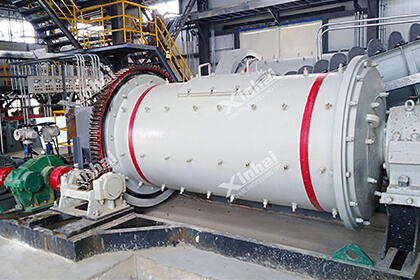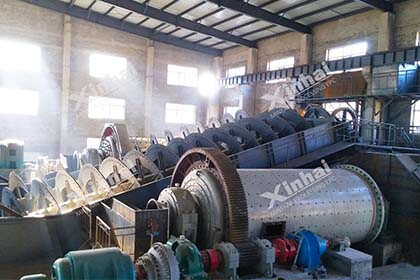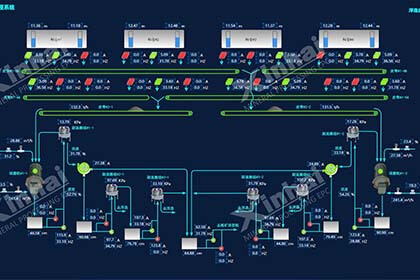What is the Ball Milling in Mineral Process?
 Laura
Laura
 Apr 30, 2022
Apr 30, 2022
 1954
1954
If you want to know more details about equipment, solutions, etc, please click the button below for free consultation, or leave your requirements!
 Xinhai grinding machine with 300tpd capacity
Xinhai grinding machine with 300tpd capacity
Ball milling refers to the grinding process of minerals in a ball mill, which is crucial to the process of mineral processing. In this article, we will mainly introduce the definition and importance of ball milling, as well as the main equipment.
Let's start!
01 What is Ball Milling?
BackBall milling is to use the impact of falling grinding bodies (such as steel balls) and the grinding action between the grinding bodies and the inner wall of the ball mill to pulverize and mix materials. When the ball mill rotates, due to the friction between the grinding body and the inner wall of the ball mill, the grinding body is brought up in the direction of rotation and then falls down, and such materials are continuously pulverized. The grinding body has three motion states: falling type, centrifugal type and throwing type.
02 Why is Ball Milling Important?
BackIn modern industrial production, it is often necessary to pulverize and grind some materials to make them finer for use. For example, after some ores are mined, they need to be pulverized and screened for continued finishing, and some even require that the particle diameter of the pulverized ores reach the level of millimeter fineness. . In general, the crushing of rocks can be done with a pulverizer, but this can only be used for coarse grinding of rocks. In order to finely grind rocks to a finer level, a mechanical device such as a ball mill is required, relying on the ball milling process. To be done. Therefore, the ball milling process is an indispensable process in the beneficiation process, and the ball mill is the main equipment for realizing the ball milling process.
03 How does a Ball Mill Work?
BackThe ball mill is mainly composed of a cylindrical cylinder, a hollow shaft, a main bearing, a hollow shaft for feeding and discharging, an electric motor, and a large and small transmission gear. There are many lining plates in the cylinder, which can not only protect the cylinder, but also improve the grinding efficiency by raising the steel balls to a certain height. There are also a certain number of round steel balls with different diameters in the cylinder. Therefore, the steel ball is also called grinding medium.
The working principle is that the cylinder rotates slowly through the transmission device, and the material is fed from the feeding end of the cylinder. Due to the continuous feeding of the material, the pressure of the material in the cylinder causes the material in the cylinder to move from the feeding end to the discharging end. The material that reaches the finished particle size is discharged from the discharge end of the cylinder.
04 Main Classifications of Ball Mill
BackIn actual production, ball mill is the most commonly used equipment for crushing materials. Its characteristics are mainly reflected in the large crushing ratio, simple structure and reliable working problems. With the needs of production, many different types of ball mills have emerged. According to different classification standards, there are many classification methods for ball mills. We will mainly talk about 3 classification methods below.
4.1 According to the Different Discharge Methods of Ball Mill
Generally, ball mills are divided into two categories, one is the center discharge ball mill (overflow ball mill). The other type is the peripheral discharge ball mill (lattice ball mill). The structure of the two types of ball mills is basically the same, the difference is that there is no ore discharge grid in the barrel of the overflow type ball mill. Due to the different discharge characteristics, the two types of ball mills also have their own uses, and each has its own advantages and disadvantages. Generally, the overflow type ball mill has a finer grinding fineness and is more suitable for the regrinding of materials. The working performance and production capacity of the grid ball mill are better than that of the overflow type ball mill, but its structure is slightly more complicated, and the particle size of its grinding products is also larger than that of the overflow type ball mill, so it is more suitable for the rough grinding of materials.
4.2 According to Different Working Methods of Ball Mill
Ball mills can also be divided into continuous ball mills and batch ball mills. As the name implies, the different working methods of the two determine their different working characteristics. The ball mills used in mineral processing plants and coal-water slurry plants end with continuous ball mills. When processing chemical products such as ceramic raw materials, glazes, etc., due to the characteristics of materials, intermittent ball mills are required for grinding. The batch ball mill can control the particle size of the material by adjusting the grinding time, but its grinding efficiency is not high and the operation is not very convenient.
4.3 According to the Way the Ball Mill Barrel is Placed
Ball mills can also be divided into vertical ball mills and horizontal ball mills. Vertical ball mill is a new type of ball mill with the cylinder fixed. After a lot of experiments, it is found that the vertical ball mill has the advantages of high grinding efficiency, low energy consumption and low noise. This also makes the vertical ball mill favored by more and more users.
05Summary
BackIn this article, we mainly talk about the ball milling process and the main classification of ball mills. I believe we have a general understanding of the ball milling process. However, in the actual beneficiation process, it is also necessary to select a suitable ball mill to complete the ball milling process according to the specific ore conditions, particle size, hardness and other characteristics, so as to obtain the maximum benefit for the beneficiation plant.
Click the chat button at the bottom of the page to get more information about the ball milling process.
 +86 18716000713
+86 18716000713 xlyin@xinhaimining.net
xlyin@xinhaimining.net




 Message
Message Chat Now
Chat Now

















